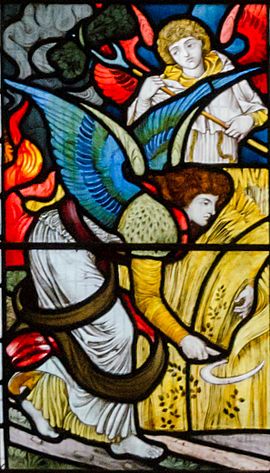Edward Holmes Jewitt facts for kids

Edward Holmes Jewitt (born 1849, died 1929) was a talented artist who worked with stained glass and other art forms. He was part of a group called the Pre-Raphaelites. These artists liked the detailed and colorful style of art from before the time of the famous artist Raphael.
Edward Jewitt was one of the main designers for a company in Lancaster called Shrigley and Hunt. This company made beautiful stained-glass windows and church decorations. In recent years, people have started to notice and admire his artwork more and more.
Contents
Edward's Family and Early Life
Edward Jewitt came from a family of artists and people who loved history. His grandfather, Arthur Jewitt, wrote books about local history and how to draw things accurately.
One of his uncles, Llewellynn, was a wood-engraver (someone who carves pictures into wood for printing). He was also an art historian and a journalist. Another uncle, Orlando, was also a wood-engraver. He was especially good at illustrating books about Gothic architecture, which is a style of building often seen in old churches.
Edward's father, Henry, worked for Orlando. So, Edward grew up in a family where art, church history, and building design were very important. He was born in Headington, Oxfordshire. When he was eight, his family moved to London. We don't know much about his school days or first jobs. But in September 1877, he started working for Shrigley and Hunt in Lancaster as a stained-glass designer.
Edward's Art Career
When Edward Jewitt joined Shrigley and Hunt, another talented designer named Carl Almquist was already there. But Edward was given the same important role as Carl. The three of them – Arthur William Hunt (the owner), Carl Almquist, and Edward Jewitt – worked very closely together.
They used a style called Aesthetic art. This style focused on beauty and art for art's sake. Carl's ideas came from famous artists like Edward Burne-Jones and Henry Holiday. Edward's ideas also came from Burne-Jones, as well as another well-known artist, Dante Gabriel Rossetti.
At first, Edward and Carl often worked on projects separately. Later, they found a way to work together. Edward would either oversee or paint a watercolor picture. From this, Carl would then create a more detailed drawing, called a cartoon, which was used to make the actual stained-glass window.
Edward brought special skills to their team. He understood the different qualities of the raw materials used for stained glass. He also knew a lot about iconography, which is the study of symbols and images in art, especially religious art. Plus, he was very good at drawing biblical figures in a way that showed their true feelings.
Together, Carl and Edward created a unique style for Shrigley and Hunt. Their windows used subtle, gentle colors at first, which became richer over time. They also featured delicate drawings. This special style became famous for the company and lasted for many years into the 20th century.
Edward designed many windows for churches and buildings in different parts of England. You can find his work in the Home Counties, the East Midlands, Yorkshire, and especially in the north-west of England. There are also some examples of his work scattered in other places. Besides stained glass, he also created painted tiles, murals (wall paintings), reredoses (decorated screens behind altars), and pattern designs. He even helped restore old medieval wall-paintings on at least one occasion.
Edward's Life Outside Work
Edward Jewitt married Edith Maria Pike in Lancaster Priory in 1878. They had children, including a son named Austin Jewitt. Austin also worked for Shrigley and Hunt on design projects for a couple of years (from 1900 to 1902). Edward's nephew, Clement William Jewitt, who was a sculptor, also did one project for the company.
Edward first lived in Lancaster. Later, he moved to Morecambe and then to a small coastal village called Hest Bank. This village was about five miles north of Lancaster. Edward used to walk to work every day from Hest Bank. His employer, Arthur Hunt, wasn't always happy about this, as he wished Edward would spend more time at his desk! Edward Jewitt continued to work for Shrigley and Hunt until he passed away in 1929.
List of works



